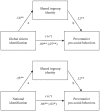A world together: Global citizen identification as a basis for prosociality in the face of COVID-19
- PMID: 36751503
- PMCID: PMC9892534
- DOI: 10.1177/13684302211051619
A world together: Global citizen identification as a basis for prosociality in the face of COVID-19
Abstract
How do global citizens respond to a global health emergency? The present research examined the association between global citizen identification and prosociality using two cross-national datasets-the World Values Survey (Study 1, N = 93,338 from 60 countries and regions) and data collected in 11 countries at the start of the COVID-19 pandemic (Study 2, N = 5,427). Results showed that individuals who identified more strongly as global citizens reported greater prosociality both generally (Study 1) and more specifically in the COVID-19 global health emergency (Study 2). Notably, global citizen identification was a stronger predictor of prosociality in response to COVID-19 than national identification (Study 2). Moreover, analyses revealed that shared ingroup identity accounted for the positive association between global citizen identification and prosociality (Study 2). Overall, these findings highlight global citizenship as a unique and promising direction in promoting prosociality and solidarity, especially in the fight against COVID-19.
Keywords: global citizen; national identification; prosociality; shared ingroup identity; the COVID-19 pandemic.
© The Author(s) 2021.
Figures




Similar articles
-
Prosociality during COVID-19: Globally focussed solidarity brings greater benefits than nationally focussed solidarity.J Community Appl Soc Psychol. 2022 Jan-Feb;32(1):73-86. doi: 10.1002/casp.2553. Epub 2021 Jun 16. J Community Appl Soc Psychol. 2022. PMID: 34518751 Free PMC article.
-
Intergroup helping during the COVID-19 crisis: A moderated mediation with effects of ingroup identification, ingroup blame, and perceived global common fate.Curr Res Ecol Soc Psychol. 2022;3:100027. doi: 10.1016/j.cresp.2021.100027. Epub 2021 Dec 16. Curr Res Ecol Soc Psychol. 2022. PMID: 35098188 Free PMC article.
-
Prosociality and endorsement of liberty: Communal and individual predictors of attitudes towards surveillance technologies.Comput Human Behav. 2021 Dec;125:106938. doi: 10.1016/j.chb.2021.106938. Epub 2021 Jul 1. Comput Human Behav. 2021. PMID: 35228773 Free PMC article.
-
Relationship between global identity and pro-environmental behavior and environmental concern: a systematic review.Front Psychol. 2023 Apr 17;14:1033564. doi: 10.3389/fpsyg.2023.1033564. eCollection 2023. Front Psychol. 2023. PMID: 37139003 Free PMC article.
-
COVID-19 and Global Health Security: Overview of the Global Health Security Alliance, COVID-19 Response, African Countries' Approaches, and Ethics.Disaster Med Public Health Prep. 2022 Apr;16(2):426-430. doi: 10.1017/dmp.2020.360. Epub 2020 Oct 2. Disaster Med Public Health Prep. 2022. PMID: 33004106 Free PMC article. Review.
Cited by
-
Political party affiliation, social identity cues, and attitudes about protective mask-wearing during the COVID-19 pandemic in Germany.PLoS One. 2024 Jun 6;19(6):e0302399. doi: 10.1371/journal.pone.0302399. eCollection 2024. PLoS One. 2024. PMID: 38843142 Free PMC article.
-
Restorativeness mediates the effect of a brief virtual reality mindfulness exposure with a multi-ethnic group in a natural environment on global identity salience: a pilot study with adolescents.Front Psychol. 2025 Jun 26;16:1593273. doi: 10.3389/fpsyg.2025.1593273. eCollection 2025. Front Psychol. 2025. PMID: 40642038 Free PMC article.
-
Prosociality and health: Identification with all humanity is a replicable predictor of prosocial motivation for health behaviors.Front Psychol. 2023 Jan 12;13:1052713. doi: 10.3389/fpsyg.2022.1052713. eCollection 2022. Front Psychol. 2023. PMID: 36710834 Free PMC article.
-
Does Activating the Human Identity Improve Health-Related Behaviors During COVID-19?: A Social Identity Approach.Front Psychol. 2022 Mar 23;13:810805. doi: 10.3389/fpsyg.2022.810805. eCollection 2022. Front Psychol. 2022. PMID: 35401362 Free PMC article.
References
-
- Bates D., Mächler M., Bolker B., Walker S. (2015). Fitting linear mixed-effects models using lme4. Journal of Statistical Software, 67, 1–48. 10.18637/jss.v067.i01 - DOI
-
- Bonetto E., Delouvée S., Mahfud Y., Adam-Troian J. (2020). National identification, a social cure for COVID-19? Evidence from 67 countries. PsyArXiv. 10.31234/osf.io/294r5 - DOI - PubMed
LinkOut - more resources
Full Text Sources
